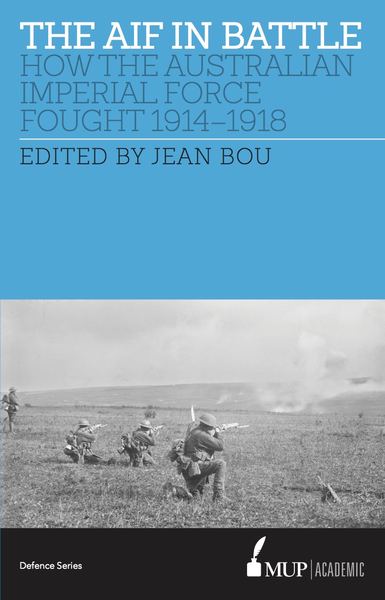By the end of the First World War, the combat formations of the Australian Imperial Force (AIF) in both France and the Middle East were considered among the British Empire’s most effective troops. How the force came to be so was not due to any inherent national prowess or trait. Instead, it was the culmination of years of training, organisational change, battlefield experimentation and hard-won experience – a process that included not just the Australians, but the wider British Expeditionary Force (BEF) as well. The necessity to fight and win was the driver of invention and adaptation during this horrible war.

The AIF in Battle brings together some of Australia’s foremost military historians – Jean Bou, Robert Stevenson, Garth Pratten, David Horner, Michael Molkentin, Damien Finlayson, Aaron Pegram, Meleah Hampton, Rhys Crawley and Roger Lee. They outline how the military neophytes that left Australia’s shores in 1914 became battle-winning troops by 1918. The book traces the evolution of several of the key arms of the AIF, including the infantry, the light horse, the artillery, and the flying corps, and also considers how the various arms worked together alongside other troops of the British Empire to achieve a remarkably high level of battlefield effectiveness.
Some chapters are relatively well known threads in the fabric of our military history. Others such as Aaron Pegram’s account of trench raiding to instil aggression and maintain tactical agility throw new light on Australian small-unit discipline in the frustrating and dangerous static warfare of the Western Front. Similarly, the origins of close air support are discerned in Michael Molkentin’s chapter as the newly-formed Australian Flying Corps made its presence felt in photographic reconnaissance, close support for Allied armies and as an instrument of ‘deep’ destruction.
David Horner’s chapter on the Australian commanders is excellent. The pre-war reliance on a defence based primarily on militia units was soon demonstrated to be completely inadequate in modern warfare. Hard and costly lessons were learned from Gallipoli to Fromelles to Bullecourt. The carnage earned widespread dissatisfaction with a British High Command apparently indifferent to casualty lists. Pressure from Hughes’ government saw more Australian commanders promoted and names such as John Monash, Talbot Hobbs, Charles Rosenthal, and John Gellibrand were at last acknowledged in reports as they assumed higher command appointments. Horner’s final assessment is instructive: “The existence of a multitude of competent Australian commanders by 1918 was an outcome that could only have been dreamed about when the AIF had been formed four years earlier. With this reservoir of expertise, the second AIF in the Second World War was led by experienced Australian commanders from the first day. Few of them had to learn their trade on the job.”
Rhys Crawley’s ‘Backs to the Wall’ chapter critically analyses the period January to June 1918 when the Australian Corps helped to blunt the German spring offensive; before Roger Lee’s ‘The AIF and the Hundred Days: orchestration for tactical success in 1918’ chapter critically analyses the subsequent Allied offensives in which the Australian and Canadian corps played a significant part in securing victory. Objectively, Lee observes that “the AIF was not the only BEF corps to achieve a high degree of tactical competence, and the Australian performance was itself not without its own occasional blemishes.”
Jean Bou is a lecturer at the Strategic and Defence Studies Centre, the Australian National University, where his teaching responsibilities include lecturing at the Australian Command and Staff College. A war historian with an interest in operations in the late-19th and 20th centuries, he is the author and co-editor of several books on Australian military history, including Light Horse: a History of Australia’s Mounted Arm and Duty First: the Royal Australian Regiment, 1946-2006. He is also the lead author for the forthcoming fourth volume of the Official History of Australian Peacekeeping, Humanitarian and Post-Cold War Operations.
The AIF in Battle includes several images embedded in the text, numerous tables and three good-quality maps. Bou provides an introduction but no conclusion or summary. There is a list of abbreviations, notes with each chapter and a detailed index. A number of appendices provide a number of organisational wiring diagrams.
The AIF in Battle is a comprehensive analysis of the evolution of the Australian military in war – its strengths, weakness and ultimate battlefront success. It could have been enhanced with the inclusion of a chapter specifically regarding tanks and their integration; and one on how the British Expeditionary Force learned to learn through critical analysis, experimentation, notes (or developing ‘doctrine’) and training. In any event, it is highly recommended to those interested in the evolution of Australian military capability between 1914 and 1918.
Contact Marcus Fielding about this article.






